Cable exercises are a great place to start if you want to add some variety to your shoulder workout routine.
If you’re not using cables for shoulder work, you’re leaving a lot of potential on the weight room floor.
Try this cable-only workout for a few weeks to challenge your muscles and give your shoulder joints a break from free weights, promoting growth and improving stability.
In this blog, we’ll take a closer look at the following points:
- Shoulders Anatomy And Function
- Benefits of the Cable Shoulder Workout
- How to Build a Shoulder With a Cable Machine
- Best cable shoulder exercises and how to perform them with proper form
Discover your body fat percentage and achieve your fitness goals with ease! Check out our body fat calculation
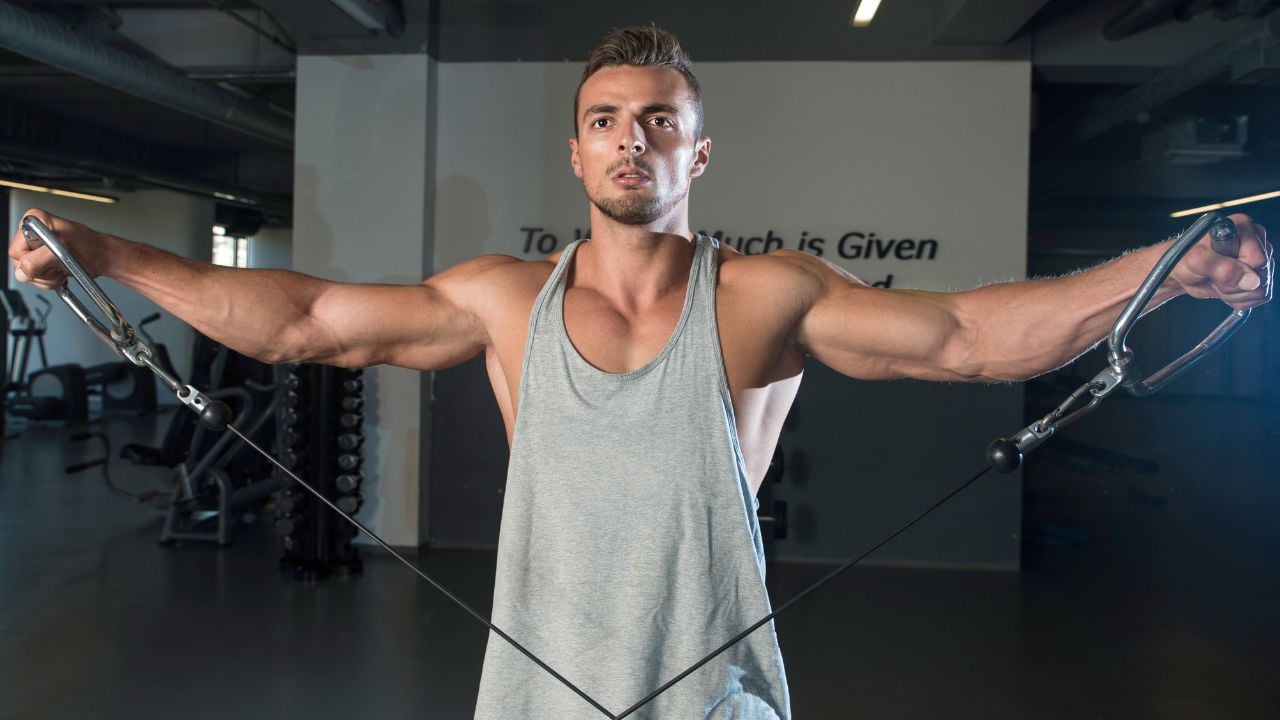
- Shoulders Anatomy And Function
- What is Cable Shoulder Exercises
- How To Build Shoulder With a Cable Machine
- 15 Best Cable Shoulder Exercises To Build Delt Size
- 1. Cable Shoulder Press
- 2. Cable Front Raise
- 3. Single Arm Cable Front Raise
- 4. Cable Upright Row
- 5. One Arm Cable Lateral Raise
- 6. Cable Lateral Raise
- 7. Cable Machine Y Raise
- 8. Bent over Cable Lateral Raise
- 9. One-Arm Bent Over Cable Raise
- 10. Reverse Cable Crossover
- 11. Lying Reverse Fly (Supine Cable Reverse Fly)
- 12. Cable Twisting Overhead Press
- 13. Face Pull
- 14. Cable Shrug
- 15. Cable High Row
- Bonus: Straight Arm Lat Pull Down
- Best Techniques To Train Shoulder With Cable
- 1. Training Volume (Sets And Reps)
- Beginner Cable Shoulder Workout Plan
- Intermediate Cable Workout Plan
- Advance Cable Only Workout Plan
- Train All Shoulder Muscle With Cable Exercises
- Benefits of the Cable Shoulder Workout
- FAQ
- Are cable exercises good for the shoulders?
- Why Are Cable Shoulder Workouts Effective for Building Mass?
- Can cable shoulder exercises replace free weight exercises?
- How often should I do cable shoulder exercises?
- Can cable shoulder exercises help with shoulder pain?
- Conclusion
Shoulders Anatomy And Function
In fitness, “shoulder exercises” refer to resistance exercises that target the deltoid muscle. The shoulder is a “ball-and-socket” joint between the upper arm’s humerus bone and the scapula bone (shoulder blade).
The deltoid muscle of the shoulder consists of three separate sections or heads.
- The anterior deltoid (In front): Your front delt’s main function is to move your arm up, forward, and to your center.
- Lateral deltoid (at the side): Your lateral delt’s main function is shoulder abduction, which brings it up to the side.
- Posterior deltoid (behind): Your posterior delt’s main function is moving the arm outward and backward.
You need to work all three of them, along with the trapezius muscle in the upper back, to build an impressive shoulder. The main function of the traps is to support head movement, stabilize certain arm motions, and provide stability in pushing and pulling movements.

Want to take your gains to the next level? Discover your daily calorie needs with our free TDEE calculator
What is Cable Shoulder Exercises
Cable shoulder exercises are a good way to make your shoulder muscles stronger. Unlike free weights, cable machines utilize an adjustable weight stack for resistance. A cable runs through a series of pulleys and attaches to handles, bars, or ropes that you grasp to perform various exercises.
Cable shoulder exercises use single handles, bars, or rope attachments to enable you to train your deltoid muscles from multiple angles.
Cable machine exercises are great for the shoulder because they keep the muscles in tension throughout the entire range of motion, which helps build strength and shape the delt muscles.
Cable shoulder exercises can target all three major deltoid muscles: the anterior deltoid, the lateral deltoid, and the posterior deltoid.

How To Build Shoulder With a Cable Machine
A cable machine can come in various shapes and sizes. You can use various attachments with the cable that can hit almost every muscle group one way or another.
To structure an effective shoulder workout with a cable machine to increase mass and strength, the number of reps and sets will vary based on your fitness level, weekly workout frequency, and strength training goals.
- For strength gains, do 4 to 6 sets of 1 to 6 reps for each exercise with a weight that is at least 85% of your one-repetition maximum (1RM). The fewer reps you perform, the closer to 100% of your 1RM you should strive for.
- If your goal is hypertrophy (muscle growth), perform three sets of each exercise, using loads that are 70 to 85% of your 1RM for 8 to 12 reps.
- When training for endurance, it is usually recommended to use higher reps (15 to 20 repetitions) and moderate loads, with a weight that is at least 50 to 70% of your 1RM.
15 Best Cable Shoulder Exercises To Build Delt Size
Try this cable rope shoulder workout for a few weeks to give your shoulder joints a break from free weights while still challenging your muscles and forcing them to grow.
- Cable Shoulder Press
- Cable Front Raise
- Single Arm Cable Front Raise
- Cable Upright Row
- One Arm Cable Lateral Raise
- Cable Lateral Raise
- Cable Machine Y Raise
- Bent over Cable Lateral Raise
- One-Arm Bent Over Cable Raise
- Reverse Cable Crossover
- Lying Reverse Fly (Supine Cable Reverse Fly)
- Cable Twisting Overhead Press
- Face Pull
- Cable Shrug
- Cable High Row
1. Cable Shoulder Press
If you’re looking for straightforward cable machine shoulder exercises to add to your routine, the cable shoulder press is a great staple exercise to get you started.
It is a variation of the shoulder or overhead press, and it’s one of the best exercises for building size and strength.
Even though you might not see many people using the cable machine for shoulder presses, mixing in your shoulder workout is a fantastic exercise for extra variety.
The angle of the cable overhead press can help recruit new muscle fiber that’s not engaged much with other types of shoulder presses because the force is pulling down behind you.
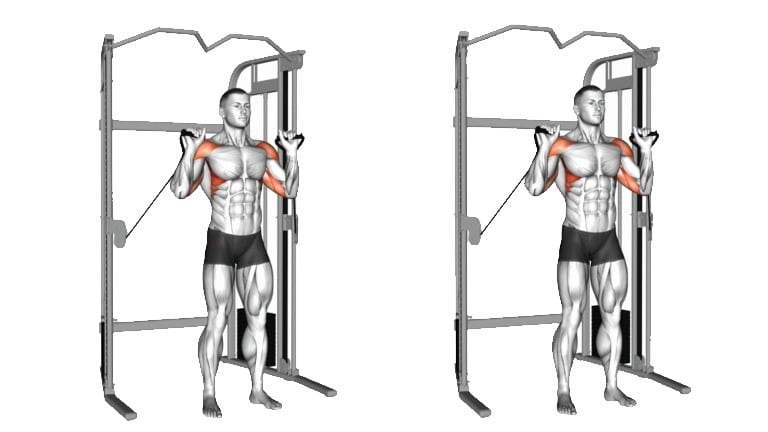
How To Do Cable Shoulder Press
- Stand between a low pulley cable machine with two cables attached to the machine.
- Bend down, grab the cables, and then bring them to your shoulders, as this will be your starting position.
- Keep your back straight, head up, and chest up, and extend through your elbows.
- Push the handles up towards the ceiling over your head.
- Hold for a count at the top, then return to the starting position.
- Repeat for the desired number of repetitions.
Tips
- Try to stand as close to the cable machine as possible. If you stand too far away, the weight will pull you back, placing stress on your lower back and making the exercise more difficult.
- Exhale during effort, and inhale during rest.
- Keep a controlled motion and avoid jerky movements
2. Cable Front Raise
The cable front raise is a cable or machine-assisted shoulder exercise focusing on the anterior deltoid.
It is an isolation exercise that athletes and regular gym goers primarily perform for improved size and strength in the anterior deltoid muscle group.
You can also perform the cable front raise using a rope attachment or a single stirrup, one arm at a time.

How To Do Cable Front Raise
- Attach a straight bar to a low cable pulley. Grab the bar using a shoulder-width or wider overhand grip.
- Stand close to the pulley with your body upright, your shoulders pulled back.
- Exhale as you pull the bar up the front of your body until the bar is at shoulder height.
- Hold for a count of two. Inhale as you lower the bar to the starting position.
- Repeat for the prescribed number of repetitions.
Tips
- Keep your shoulders back, chest out, and body upright.
- Pause for a moment at the top position.
- Try not to bounce at the top of the movement; allow the shoulders to flex and then lower slowly.
3. Single Arm Cable Front Raise
When doing a shoulder workout with a cable machine, you can add plenty of single-arm exercises to correct potential imbalances.
It is one of the most effective front raise variations that works the front deltoid muscles.
It’s a unilateral exercise, so you only work one shoulder at a time.
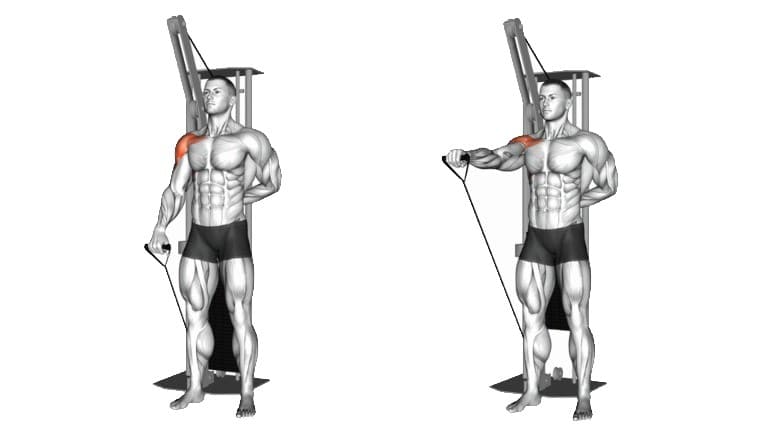
How To Do Single Arm Cable Front Raise
- Attach a single grip handle to a low pulley cable machine.
- Stand facing away from the machine and grip the handle with your right hand using an overhand grip (palm facing down).
- For balance, stagger your feet. The foot in front should be the one that is opposite to your working arm.
- Keeping your elbow very slightly flexed, exhale as you raise the stirrup (handle) forward and upward in a semicircular motion until your arm is above horizontal.
- Hold for a count of two. Inhale as you slowly reverse the motion and lower the stirrup to the starting position.
- Repeat the exercise with your opposite arm.
Tips
- This is an isolation exercise, so the focus should be on form and muscle contraction, not weight.
- Do not allow the handle to touch your body, and do not allow your body to move (or swing) throughout the movement.
- Keep your back straight and your head up. Keep your body still. Only your arm should move.
4. Cable Upright Row
The cable upright row is a movement that targets many of the large muscles in the upper back and shoulders, which is key for many movements in strength, power, and fitness sports.
Upright row activates all major shoulder muscles, making it excellent for upper body stability and conditioning. It is important to do this regularly to improve your posture and protect yourself from injury.
Cable machines keep tension on the muscles throughout the entire range of motion, ultimately increasing muscle activation and hypertrophy.

How To Do Cable Upright Row
- Attach a straight bar to a low cable pulley.
- Grab the bar using a shoulder-width or wider overhand grip.
- Stand close to the pulley with your body upright, your shoulders pulled back.
- Exhale as you pull the bar up the front of your body until it reaches your lower or middle chest level.
- Do not pull the bar up any higher. Hold for a count of two.
- Inhale as you lower the bar to the starting position.
Tips
- Bend slightly at the knees and stand with feet shoulder-width apart.
- Keep your shoulders back, chest out, and body upright.
Know More: Upright Row: Muscle Worked, Form, Benefits, Variations
5. One Arm Cable Lateral Raise
The one-arm cable lateral raise is an isolated shoulder exercise that targets the deltoids while increasing stability in both the wrists and the core.
It works the lateral head of the deltoid muscle, which is the rounded muscle at the very top of each shoulder.
An advanced version of this exercise is to stand so the cable is behind you when you lift. This can keep your shoulders from rounding forward and also activate the rear delts.

How To Do One Arm Cable Lateral Raise
- Stand next to a cable pulley machine with your feet shoulder-width apart and the handle attachment adjusted to the lowest setting.
- Push your chest forward and point your shoulders back while slightly bending both knees to maintain good posture.
- Grab the handle and stand straight up with your arm fully extended and feet facing forward.
- Maintaining a slight bend in your working elbow, raise your arm up to shoulder height.
- Hold for a second, and then slowly lower the weight back to the starting position.
Tips
- Keep your torso still, your back straight, and your elbow slightly bent.
- Don’t just swing your arms. Keep controlled motion throughout the exercise.
- Always use weights that you can handle comfortably.
6. Cable Lateral Raise
The cable lateral raise is one of the best two-arm cable shoulder exercises you can do while you work out your side deltoid.
There are multiple variations of the lateral raise, but they all have the same common goal: to build the lateral delts.
You should begin with a lighter weight to achieve optimal performance.
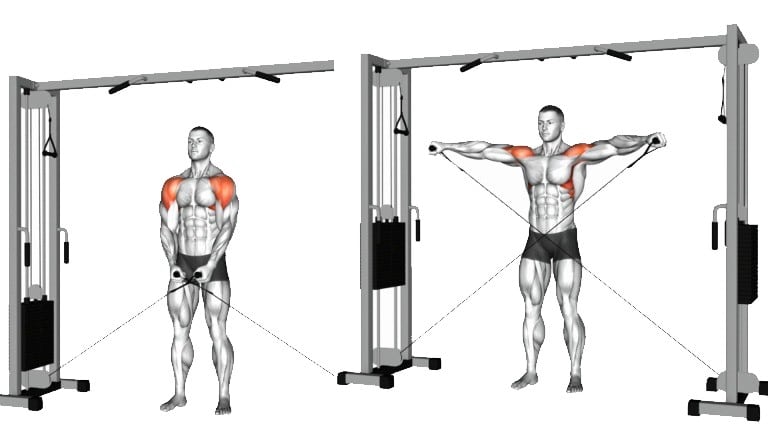
How To Do Cable Lateral Raise
- Attach single-grip handles to the lowest point of the cable pulley system.
- The handle from the right pulley should be in your left hand, and the handle from the left pulley should be in your right hand. The cables should be crossed and pulled tightly.
- With elbows slightly bent, raise your arms to shoulder level, leading with the elbow.
- Slowly lower your arms back down until you feel a stretch in your delts and repeat.
Tips
- The form is an essential part of this exercise.
- Don’t just swing your arms. Keep motion controlled throughout the exercise.
- Always use weights that you can handle comfortably.
7. Cable Machine Y Raise
If you’re looking for a way to get more creative with your cable shoulder workout, why not try cable Y-raise?
It is a fantastic exercise for the whole shoulder (deltoid) that activates all deltoid fibers: anterior, lateral, and posterior, but it mainly targets the lateral shoulder.
This exercise combines horizontal shoulder abduction with external shoulder rotation. It is strengthening the external shoulder rotators and the internal shoulder rotators.

How To Do Cable Machine Y Raise
- Stand facing between two low cable pulleys, with each hand holding the handle of the cable of the opposite pulley.
- Push your chest forward and point your shoulders back while slightly bending both knees to maintain good posture.
- Stand straight up with your arm fully extended and feet facing forward.
- Maintaining a slight bend in the elbows, raise your arms upwards and outwards, forming the letter ‘Y’ with your whole body.
- Hold for a second, and then slowly lower the weight back to the starting position.
Tips
- Maintain a fixed, slightly bent elbow position throughout the exercise.
- Keep your torso still, your back straight, and your elbow slightly bent.
- Don’t just swing your arms. Keep controlled motion throughout the exercise
8. Bent over Cable Lateral Raise
A bent over cable raise is an excellent exercise to train and isolate the rear deltoid muscle. There are, however, many bent-over cable lateral raise variations that you can try out that may require different types of bent-over cable lateral raise equipment.
It provides constant stress on the muscle. Unlike dumbbell raises where the resistance varies during the lift, the cable pulley affords a uniform resistance throughout the motion.

How To Do Bent over Cable Lateral Raise
- Grab the handles attached to two low pulleys (left-side handle in right hand, right-side handle in left hand).
- Stand in the middle, then bend forward at the waist with your back straight and parallel to the floor.
- Raise your hands upward in an arc to shoulder level so the cables cross over.
- Lower the handles back down to the start position, your right hand directly in front of the left ankle and your left hand in front of the right ankle.
Tips
- Pull slowly so that you are controlling the weight at all times.
- Remember to exhale while you exert.
9. One-Arm Bent Over Cable Raise
You can do this exercise using one arm at a time, allowing you to alter the range of motion by adjusting the start or finish position.
This unilateral version makes it possible to raise your hand higher and get a longer stretch at the bottom, thereby generating more work for the posterior deltoid.

How To Do One-Arm Bent Over Cable Raise
- Lean forward at the hips, place your right hand on your thigh.
- Hold a dumbbell in your left hand with your arm extended straight down.
- Raise the weight straight out to the side until your arm is parallel with the floor.
- Pause for a moment at the top of the motion before slowly lowering the weight back down to the starting position.
- Repeat with the right arm.
10. Reverse Cable Crossover
The Reverse Cable Crossover helps you to strengthen and tone the rear deltoid muscles.
It is a very effective and functional exercise for building muscle and strength in the posterior deltoids. Additionally, it helps to improve shoulder stability and posture.

How To Do Reverse Cable Crossover
- Stand in the center of a cable crossover apparatus.
- Start with hands crossed in front of you at shoulder height, with the left high cable in your right hand and the right in your left hand.
- Pull your elbows out and back as far as possible using your rear deltoid.
- Then, slowly return to the starting position.
Tips
- The posterior deltoid is best targeted with your torso upright, not leaning too far forward or back.
- Keep a controlled motion and avoid jerky movements.
11. Lying Reverse Fly (Supine Cable Reverse Fly)
The lying reverse fly is the perfect exercise to hit the rear delts as well as the upper back muscles.
Completing this exercise in a supine position on your back allows you to purely focus on contracting your rear delts to pull the cables down to the sides.
This exercise helps to isolate the target muscles and reduce the chance of cheating or compensating with other muscle groups.
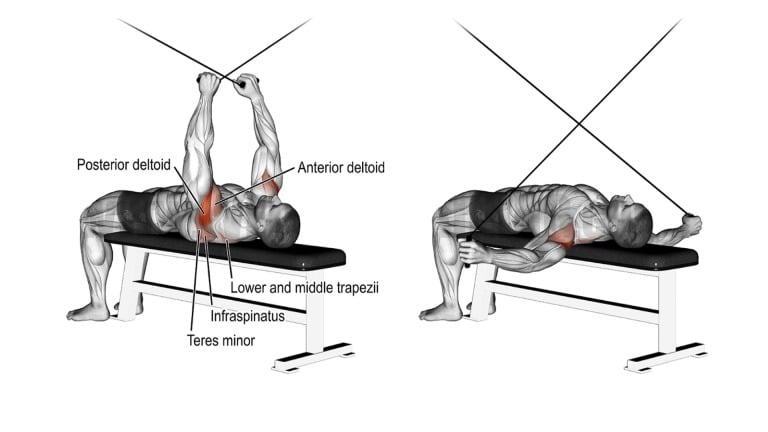
How To Do Lying Reverse Fly
- Position a flat bench between two high pulleys.
- Lie supine (on your back) holding the pulleys’ handles.
- The handle from the right pulley should be in your left hand, and the handle from the left pulley should be in your right hand.
- The cables should be crossed and pulled tightly.
- Keeping your arms perpendicular to your torso and your elbows slightly bent, exhale as you pull your arms open and out to the sides.
- Hold for a count of two. Inhale as you slowly return to the starting position.
- Repeat for desired reps.
Tips
- When you lie down, make sure that your shoulders are lined up with the pulleys. This will ensure optimal mechanical leverage.
- Keep the movement slow and deliberate.
12. Cable Twisting Overhead Press
The cable twisting overhead press is another effective single-arm cable shoulder exercise. It is a very effective shoulder press variation that works the anterior delt.
Now, it’s a pretty simple exercise, and anyone can do it effectively, making it ideal for size and strength gains.
It is brilliant for developing unilateral upper-body strength and improving your balance and the strength and stability of your core.
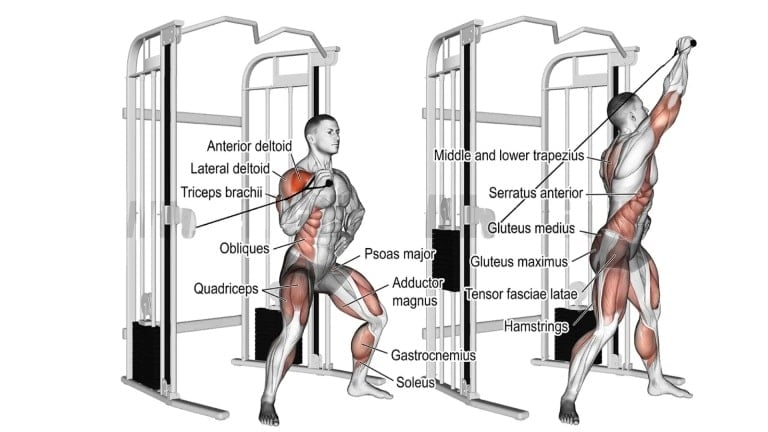
How To Do Cable Twisting Overhead Press
- Attach a stirrup (handle) to a low or waist-high pulley. Grasp the stirrup with one hand.
- Spread your legs and squat a little, keeping your torso upright.
- Position the stirrup to the side of your body, with your elbow flexed and tucked into your side.
- Exhale as you straighten your legs, twist your body, and press the stirrup diagonally upward and away from the pulley.
- Hold for a count of two. Inhale as you reverse the motion and return your body and the stirrup to the starting position.
- Complete the desired number of reps with your right arm.
- Repeat the exercise with your opposite arm.
Tips
- You can place your free hand on your hip. You can squat as deep as you want to.
- Furthermore, you can only perform this exercise with one arm at a time.
13. Face Pull
Face pull is a cable machine exercise that primarily targets the rear deltoid and, to a lesser degree, also targets the trap, biceps, and triceps.
Use a cable pulley machine to pull the weight straight toward your forehead. This exercise prevents muscular imbalance and builds overall shoulder strength.

How To Do Face Pull
- Grab the ends of the rope attachment using a neutral grip (palms facing each other) and slightly lean back.
- Pull the rope toward your face as you spread the ends of the rope so they end up on the sides of your ears just above your shoulders in the finish position.
- Hold this position for a second as you squeeze your shoulder blades together, contracting rear delts and middle traps as hard as possible.
- Then, slowly return the rope to the start position and repeat for reps.
Tips
- Stand straight with your feet in a comfortable, balanced stance.
- Be sure to exhale when pulling weight toward your face.
- Think about trying to pinch your shoulder blades as tight as possible when pulling weight toward your face.
- Your upper arms should be straight out to your sides with elbows bent.
Related Post: Best Cable Trap Exercises For Strength & Size
14. Cable Shrug
The cable shrug is a variation of the shoulder shrug and one of the best upper trap cable exercises to build the upper back’s trapezius muscle.
Cable machine shrug, one of the best exercises for isolating the traps, offers versatility to improve development further.
The best variations of cable shrugs are:
- One Arm Cable Shrug
- Cable Shrugs Behind The Back

How To Do Cable Shrug
- Grab a cable bar attachment that is attached to a low pulley.
- Your hands should be shoulder-width apart or slightly wider if you wish. Your hands should be facing down.
- Stand close to the pulley and extend your arms in front of you while holding the bar.
- Raise your shoulders and lift the bar as high as you possibly can.
- Exhale while performing this movement. Hold the contraction at the top for a second.
- Slowly lower the bar to its starting position.
- Repeat for the desired number of reps.
Tips
- Prevent from rolling your shoulders, as this is an incorrect form and can result in injury.
Read More To Know More: Shrug Exercise: Benefits, Variations, Muscles Used, Tips
15. Cable High Row
Half kneeling high cable row rope is a tremendous exercise that effectively works many muscles, including the shoulder, back, wing, and trapezius muscles.
Using this exercise gives people with shoulder issues an exercise to get the benefits of rows.
In addition, cable row is one of the most effective corrective exercises that help compensate for poor posture and shoulder dysfunction.
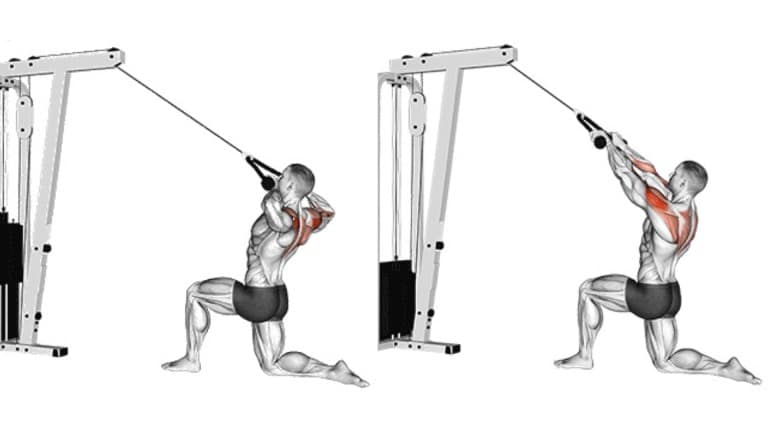
How To Do Cable High Row
- Set the cable up at a high point with the rope attachments
- Grab the rope with both hands using an overhand grip.
- Then, take a step back and get onto your knees, facing the cable machine.
- Starting with your arms stretched out and away, pull back through your elbows until your hands are just in front of your shoulders.
- Slowly return to the starting position.
- Repeat for desired reps.
Tips
- Don’t lean backward to pull the weight towards you.
- Focus on the mind-muscle connection to pull down by using your back muscles.
Bonus: Straight Arm Lat Pull Down
Finally, if you’re looking for one more effective shoulder exercise that you can do with a cable, try the straight arm lat pulldown.
It is one of the best exercises to strengthen your lats and rear shoulder with a cable machine.

How To Do Straight Arm Lat Pull Down
- Take an overhand grip that is wider than shoulder-width on a lat bar attached to the pulley on the lat pulldown bar.
- Position yourself with your feet flat on the floor, chest up, and low-back arch exaggerated.
- Pull your shoulder blades together as you squeeze your lats to initiate the movement, pulling the bar down smoothly to your midsection.
- Hold the contraction for a moment, then slowly return the bar all the way back to the starting position.
Tips
- Don’t allow the head to jut forward as you pull.
- Keep your elbows slightly flexed and your body still
Best Techniques To Train Shoulder With Cable
The cable machine is best used for hypertrophy rather than strength and power, so you won’t be trying to lift as heavy as possible but rather hone in on specific exercises with mid to high rep range.
If you need a refresher regarding rep ranges and desired outcomes, you can follow these guidelines:
1. Training Volume (Sets And Reps)
Of course, the number of sets and reps will be determined based on your fitness journey, but here is a great starting point:
The number of reps you should do depends on your goals, whether they are to increase strength or build muscle mass and endurance.
- 0-5 Reps—Power/Strength
- 6-8 Reps—Strength/Hypertrophy
- 8-15 Reps—Hypertrophy
- 15+ Reps—Endurance
| Level | Sets | Reps | Frequency |
|---|---|---|---|
| Beginner | 2-3 | 8-12 | 1-2 times per week |
| Intermediate | 3-4 | 8-12 | 2-3 times per week |
| Advanced | 4-5 | 8-15 | 2-3 times per week |
Beginner Cable Shoulder Workout Plan
| Exercise | Sets | Sets x Reps | Rest |
|---|---|---|---|
| Standing Cable Shoulder Press | 3-4 | 10-12 | 90s |
| Front Cable raise | 3-4 | 12-15 | 90s |
| Cable Rear Delt Flys | 3 | 12-15 | 90s |
Intermediate Cable Workout Plan
| Exercise | Sets | x Reps | Rest |
|---|---|---|---|
| Cable Twisting Overhead Press | 3-4 | 8-10 | 60s |
| Cable Lateral Raises | 3-4 | 10-12 | 60s |
| Cable Face Pulls | 3 | 10-12 | 60s |
| Upright Row | 3 | 10-12 | 60s |
Advance Cable Only Workout Plan
| Exercise | Sets | Sets x Reps | Rest |
|---|---|---|---|
| Cable Shoulder Press | 4 | 8-10 | 60s |
| One Arm Cable Lateral Raise | 4 | 10-12 | 60s |
| Cable Reverse Flys | 4 | 10-12 | 60s |
| Cable Face Pulls | 3-4 | 12-15 | 60s |
| Cable Shrug | 3-4 | 10-12 | 60s |
Train All Shoulder Muscle With Cable Exercises
As you saw above, many exercises engage both primary and secondary muscles.
We will need to hit all areas to build an all-around strong shoulder.
- For the front delt, you can do exercises like cable shoulder presses, cable front raises, and single-arm cable front raises.
- For lateral delt, do cable lateral raise, one arm cable lateral raise
- The rear delt can be done with exercises like bent-over cable lateral raise, face pull, and reverse cable crossover.
- The trap muscles can be done with exercises like cable shrug and cable upright row.
Benefits of the Cable Shoulder Workout
The cable shoulder (deltoid) workouts offer an effective way to train the shoulders; let’s take a look at some other benefits of shoulder exercises with a cable machine.
- Cable rope shoulder exercises are a great alternative for people who experience discomfort in their joints during the press.
- Cable Shoulder workouts are more evenly distributed, and you have more of a constant load on your shoulder muscles throughout the whole range of motion.
- The cable machine deltoid workout offers almost unmatched versatility because you can easily change the load, angle, grip positioning, and body positioning.
- The shoulder workout with cable gives your muscles almost uninterrupted time under tension and a massive pump — each of which can help optimize muscle growth.
- Cable machines are a safe and efficient tool to incorporate into your normal workout program. The smooth, flat resistance reduces wear and tear on the joints, especially the wrists, elbows, and shoulders.
- The cable machine deltoid workout offers a smooth, controlled motion that can be manipulated by the variables above to deliver the exact resistance you’re looking for.
- Varying the body’s position and the cable’s direction, you can work out various parts of the deltoid muscles.
FAQ
Are cable exercises good for the shoulders?
Yes, cable rope shoulder exercises are a great way to build strong, powerful shoulders. Using the cable machine, you can hit all three deltoids from different angles and through a range of motions.
You can also change body positioning, weight load, and attachments used, altering your grip and targeting your muscles differently.
Why Are Cable Shoulder Workouts Effective for Building Mass?
Cable rope shoulder workouts are effective for building muscle mass for the following reasons:
- Cable exercises provide consistent tension throughout the range of motion.
- Cable machines are a safe and efficient tool to incorporate into your normal workout program.
- Cables can offer freedom of movement.
- Cables can be set in the direction that hits the muscle fibers of deltoids (front deltoid, side deltoid, and rear deltoid muscles).
- Cable setup can increase the range of motion for common shoulder exercises.
Can cable shoulder exercises replace free weight exercises?
Cable shoulder exercises can be helpful, but they shouldn’t be used as a replacement for free-weight exercises. It should be a part of a complete shoulder workout routine.
How often should I do cable shoulder exercises?
It is recommended to perform shoulder exercises 2-3 times per It is recommended that shoulder exercises be performed 2-3 times per week, with at least one day of rest between each session.
Can cable shoulder exercises help with shoulder pain?
Cable shoulder exercises can help strengthen and stabilize the shoulder muscles, which may help reduce the risk of shoulder pain and injuries.
However, if you are currently experiencing shoulder pain or injury, it is important to consult with a medical professional before beginning any new exercise program.
Conclusion
A cable shoulder Workout is highly recommended for anyone interested in building a wider shoulder and who wants to gain strength.
Shoulder exercises on a cable machine can hit your shoulders from all angles, stimulating new muscle fibers to be activated for potential growth.
If you incorporate these cable shoulder exercises into your workout regimen and do it consistently, the results will speak for themselves. It allows for targeted muscle development and provides an overall 3D look to the shoulder.
Thanks for reading. Enjoy your Workout.
References
- Campos YAC, Vianna JM, Guimarães MP, Oliveira JLD, Hernández-Mosqueira C, da Silva SF, Marchetti PH. Different Shoulder Exercises Affect the Activation of Deltoid Portions in Resistance-Trained Individuals. J Hum Kinet. 2020 Oct;75:5-14. doi: 10.2478/hukin-2020-0033. PMID: 33312291; PMCID: PMC7706677.
- Botton C, Wilhelm E, Ughini C, Pinto R, Lima C. Electromyographical analysis of the deltoid between different strength training exercises. Med Sport. 2013;17:67–71
- https://www.acefitness.org/continuing-education/prosource/september-2014/4972/dynamite-delts-ace-research-identifies-top-shoulder-exercises/

Manish brings over 10 years of hands-on experience in weight lifting and fat loss to fitness coaching. He specializes in gym-based training and has a lot of knowledge about exercise, lifting technique, biomechanics, and more.
Through “Fit Life Regime,” he generously shares the insights he’s gained over a decade in the field. His goal is to equip others with the knowledge to start their own fitness journey.
